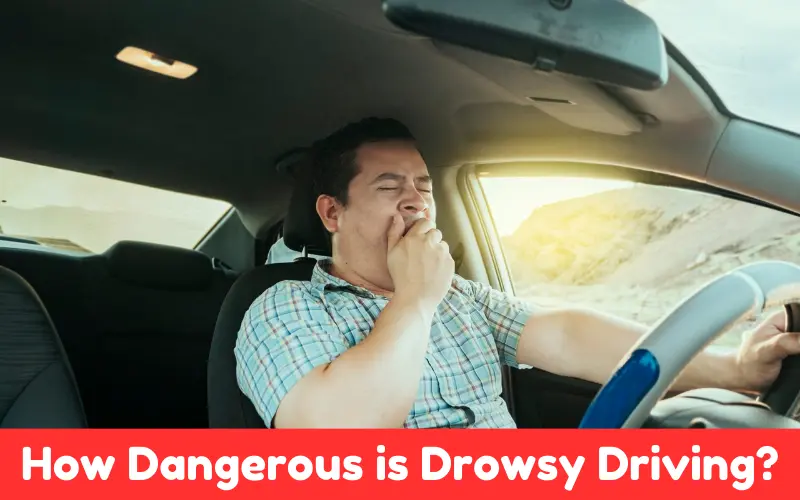Drowsy driving is a major and growing threat to the safety of roads worldwide. Although it is one of the deadliest driving impairments, it does not get as much coverage as impairments such as driving under the influence of drugs or alcohol.
But How dangerous is drowsy driving? Drowsiness negatively impacts a driver’s ability to function behind the wheel and threatens her safety and the safety of others on the road.
This paper delves into the dangers of drowsy driving, what causes it, the consequences, and how to prevent it.
Article Summary
Understanding Drowsy Driving
Drowsy driving is defined as driving a vehicle during serious drowsiness or sleepiness. Although it presents itself differently than alcohol intake, many of the same physiological consequences of drinking alcohol also result from drowsiness.
When we are drowsy, our heightened fatigue levels interfere with our driving ability. Consequently, many cognitive functions are degraded once drowsy, including reduced attention and elevated forgetfulness.
As a result, nearly every facet of driving suffers to some degree. Drowsy drivers experience slowed reaction times and compromised decision making abilities.
Undoubtedly, one of the biggest impacts of Drowsiness experienced behind the wheel is that Drowsiness affects the driver’s ability to process information quickly, hold a position within the driving lane, and properly execute instantaneous reactions to sudden changes in road conditions.
Any drowsy driving episode that lasts only a small window of time can translate into a catastrophic event on the road.
Statistics and Impact
The costs of drowsy driving can be devastating. The National Highway Traffic Safety Administration (NHTSA) estimates that drowsy driving crashes in the United States contribute to nearly 100,000 crashes annually, resulting in roughly 1,550 annual fatalities.
Studies suggest that drowsy driving accounts for up to 20 per cent of all motor vehicle accidents but comes with stigma, unlike that linked with drunk or drugged driving.
Worldwide, the problem is no different, except that the numbers might be even more exacerbated given that every year, drivers around the globe drop asleep behind the steering wheel at greater rates than in the United States.
Fatalities, injuries, and part of the economy of most countries are lost. This is certainly the case in Japan and other Asian, European, and North American countries too.
Causes of Drowsy Driving
Several factors contribute to drowsy driving:
Lack of Sleep: The most common cause is lack of sleep. Most adults need approximately 7 to 9 hours of sleep daily to function optimally.
Driving drowsy can be due to chronic sleep deprivation from demanding work schedules, family responsibilities, or lifestyle choices.
Sleep Disorders: Sleep disorders, such as sleep apnea, insomnia, and narcolepsy, often overlap with EDS and fatigue.

Sleep apnea is a condition in which the cessation of breathing during sleep interrupts the sleep rhythm, thereby leading to prolonged fatigue during the day.
Lifestyle Factors: In addition, the regularity of sleep often becomes disrupted by the normal drive to work long hours, frequent changes in work shifts, shifts across time zones, and travel.
A shift worker who regularly works day shifts but occasionally works nights and reverse commutes faces an increased risk of drowsy driving.
Drugs: Some prescription drugs, including antihistamines, antidepressants and pain medication, can result in drowsiness as a side effect of their use. Drivers must be aware of their medications and how they impact their ability to stay awake.
Signs of Drowsy Driving
Identifying signs of drowsy driving is crucial to preventing accidents:
1. Yawning Frequently
If you’re yawning without cause, it’s a sign you need to raise your oxygen levels and become more alert.
2. Heavy Eyelids
If you are having trouble keeping them open or feel that they are getting heavy, that indicates you are too tired to drive properly.
3. Difficulty Focusing
If you find that you are having a hard time keeping your eyes open, staying in your lane, or responding to traffic signals, you are probably getting drowsy.

4. Drifting from Lanes
Lane Drift is when your vehicle starts to hit the lines or larger objects. It could be a sign of impaired alertness and reaction times, likely caused by sleepiness.
5. Irritability and Mood Swings
Have you ever become irritable or suddenly snapped at a loved one for no apparent reason? Have you noticed a quick change in your mood or emotions in the last few days?
These are signs that you may be sleep deprived and need to make sure that you are fully awake before getting behind the wheel of a car.
How Dangerous is Drowsy Driving? Risks and Consequences
The risks associated with drowsy driving are significant and multifaceted:
Increased Accident Risk
Drowsy truck drivers cause their semi-truck to veer into the wrong lane and cause serious Louisville semi-truck crashes due to slow reactions and poor decision making.
It is estimated that after being awake for 18 hours with minimal sleep, a person’s driving performance may be equivalent to .05% blood alcohol concentration (BAC). After 24 hours without sleep, a person’s driving performance may be equivalent to .10% BAC.
Severity of Accidents
Between poor reaction timing and impaired judgment, drowsy drivers tend to have major accidents, which usually cause serious injuries or fatalities.
Legal Repercussions
Depending on where you live, drowsy driving can also get you into legal trouble, such as a fine, revocation of driving privileges, or jail time, especially if a resulting accident occurs.
Health Effects
Longer term, chronic drowsiness and sleep deprivation are associated with a whole host of health issues, including cardiovascular problems, obesity, diabetes and a higher incidence of mental health disorders, including anxiety and depression.
Prevention Strategies
To prevent drowsy driving, consider these strategies:
Prioritize Sleep: aim for 7 to 9 hours per night, deliver a consistent message to your circadian rhythm by going to bed and getting up simultaneously, and moderate the nighttime environment to be fit for sleep.
Take Regular Breaks: On longer trips, stop for a rest and stretch your body every 2 hours or so. Use rest stops for nap breaks.

Power Naps: A 15 to 20 minute rest can also help restore alertness and performance behind the wheel. Long naps can bring on grogginess.
Stay Hydrated and Eat Well: Dehydration and malnourishment will compound your exhaustion. Drink lots of water and eat well balanced meals when you’re feeling well.
Use Technology: Many modern cars are now equipped with drowsiness detection, alerting drivers that signs of sleepiness have been detected. These technologies can prove helpful.
Legal Aspects
Understanding the legal aspects of drowsy driving is essential:
Laws and Regulations: A number of jurisdictions have laws related to drowsy driving, particularly restrictions on how many hours commercial drivers can drive.
Rest periods might be required, and driving hour limits might be imposed to reduce fatigue related accidents.
Penalties: Legal penalties for drowsy driving are fines, points off your license, and having your license revoked or canceled. You could face jail time if you cause an accident or injury while drowsy.
Insurance Implications: They might consider drowsy driving as risky. For instance, in the event of an accident due to drowsiness, insurance companies would probably increase the premiums or deny coverage of such claims.
What To Do If You’re Affected
If you feel drowsy while driving:
Pull Over Safely: Find a safe, open place to pull over and rest. Do not drive if you feel tired. Use this time to get refreshed and recharged.
Seek Alternatives:
- Get a lift.
- Use an app taxi or public transport.
- Ask a friend or family member to pick you up.
Call a Friend: If possible, stop somewhere and ask a friend or family member to help you get to your destination safely. If you can’t stop, call a friend or family member. Get some caffeine and a snack. Take a short nap if possible.

